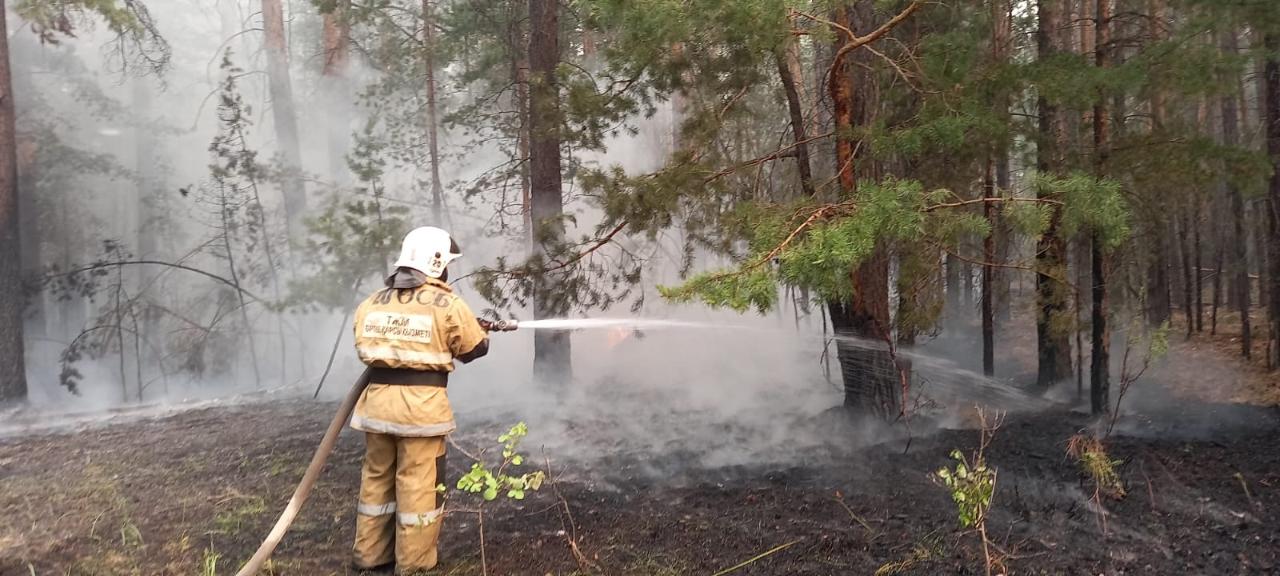ASTANA – Two days since a fire broke out in the Batpayev forestry in the Abai Region, with large areas of forest and grasslands being engulfed in flames, the fire has been declared under control, said Nurbolat Derbisov, chairman of the Fire Service Committee at the Kazakh Ministry of Emergency Situations.

The effort to eliminate the fire is still in progress. Photo credit Ministry of Emergency Situations. Click to see the map in full size. The map is designed by The Astana Times.
Additional rescuers from the city of Almaty and Almaty, Karagandy and Zhetysu regions were sent to fight the fire. At the time of writing, the area covered by fires hit 60,000 hectares, according to the ministry.
A fire broke out on June 8, burning forest trees in an initial area of 2,000 hectares. A helicopter was immediately brought in to extinguish the fire, and rescuers from three regions were sent to help with the effort, but the fire was spreading quickly.
“At the moment, the situation at the fire site has stabilized. Since the morning [of June 10], eight helicopters and personnel of the involved services started to extinguish the fire. Additional forces of the Ministry of Defense are also involved. Fire extinguishing is complicated by high temperatures, large burning area and wind gusts, in some places, up to 10 meters per second,” said Derbisov.

The area covered by fires reached 60,000 hectares. Photo credit: Kazakh Ministry of Emergency Situations
As of June 10, fire extinguishing continues at seven sites in the region, according to the ministry. More than 1,000 people, 11 helicopters, 237 units of equipment of the ministry, local executive bodies and the Ministry of Defense are involved in the effort. An aerial survey of the firefront is being carried out.
Since 6 a.m. on June 10, at least 164 water discharges with a volume of 410 tons were made to extinguish the fire.
Derbisov said three forestry workers, who were killed in the fires, have not yet been identified.
In response to the escalating disaster, the Kazakh government has swiftly implemented measures to combat the fire, while President Kassym-Jomart Tokayev, who canceled his visit to Vietnam because of the fires, dismissed Yuriy Ilyin as the Minister of Emergency Situations and appointed Syrym Sharipkhanov as the new minister to oversee the firefighting and emergency response efforts.

Syrym Sharipkhanov, 56, has served as the head of the Gabdullin Academy of Civil Protection since September 2021. Photo credit: Akorda press service
Sharipkhanov previously served as the Head of the Malik Gabdullin Academy of Civil Protection of the Ministry of Emergency Situations.
Tokayev is expected to visit the Abai Region to hold an emergency meeting and take measures to assist citizens affected by the disaster.
On June 10, Kazakh Prime Minister Alikhan Smailov convened an emergency meeting with top government officials to discuss the situation and formulate a comprehensive response. The Prime Minister stressed that all technical and human resources had been mobilized to fight the fire and ensure the safety of citizens.
Smailov demanded to provide prompt arrival of additional equipment and employees of relevant services. He also instructed the Ministry of Labor and Social Protection to consider social assistance to families affected by fires, the Ministry of Health to keep under control the timely provision of medical care to citizens if necessary, and the Ministry of Internal Affairs to ensure public order and safety of the property.
“As of today, the situation is under control. (…) There were three fires. In two areas, the fire was actually minimized. On the western outskirts in Kashtaksky forestry, fire is actively burning. On the territory of Kamyshensky forestry, the fire is almost localized. In Uspensky forestry, the work to stop the fire is in progress. Today there is no fire hazard to the settlements. The people are returning to their homes, and the threat has been completely eliminated. The forces and means of the Emergency Situations Ministry of Astana, Karagandy, Semei, and East Kazakhstan Region, as well as the forces and means of the Ministry of Defense, including 200 personnel, are involved,” said Deputy Akim (mayor) of the Abai Region Dimitriy Garikov.
According to the country’s Kazgidromet weather forecast service, rain, thunderstorms, dust storms and squalls are expected in most areas of the region, with air temperature ranging between 24 and 29 degrees Celcius, hitting 34 degrees in the south of the region.


